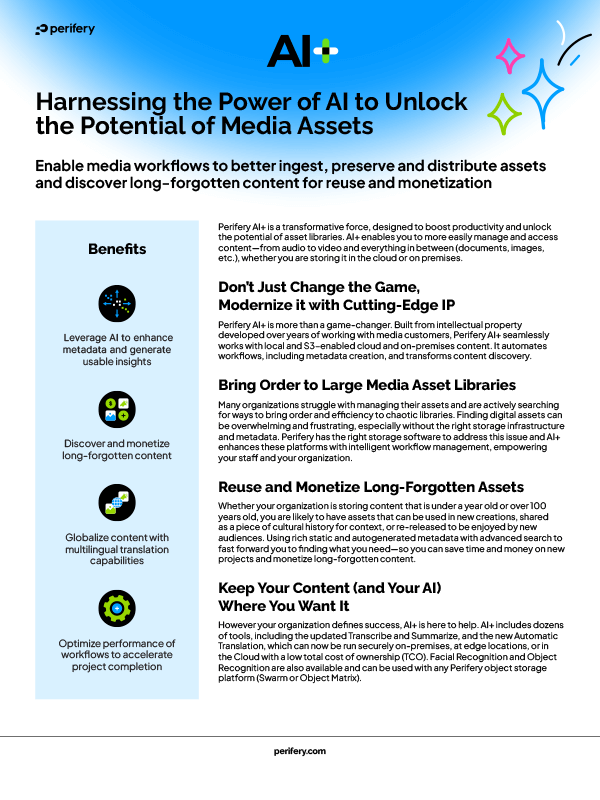
Linear Tape-Open, commonly known as LTO or tape, has evolved into a critical part of the storage infrastructure of media and entertainment businesses. It leverages the magnetic tape data storage technology and is widely used for data archiving and backup. Tape is so prevalent in the media industry that finding a media company without a significant portion of its assets stored on tape is nearly impossible. The shipment of 152.9 exabytes of total tape capacity in 2023 is a testament to tape’s ongoing importance.
In this blog, we will look at reasons why leaders of media businesses must be extra cautious with tape going forward, despite the obvious benefits they offer.
Why Tape isn’t going away anytime soon
Cost-effectiveness: LTO tapes provide a lower cost per gigabyte than most other storage media, making them a highly cost-effective option.
Energy efficiency: Because tapes are not active storage systems, they consume no power when data is at rest. This means that their energy consumption and operational expenses are generally low when compared to other storage media.
Durability: Tapes typically last for about 15–30 years, which is far more than the average lifespan of other commonly used storage hardware.
A combination of these factors makes tape an ideal choice for media and entertainment businesses to store and preserve archive libraries for the long term.
Tape is struggling to keep up with the modern media workflows
As media companies' business requirements rapidly evolve, workflows have become more demanding than ever. Let's look at some key requirements posed by high-performance media workflows today and how LTO fares against each of them.
Quick and immediate data retrieval
The media and entertainment industry is becoming more competitive by the day. Media businesses need to have their entire libraries easily, if not instantly, retrievable to promptly meet their tight production schedules and stay ahead of the competition. Tape is a sequential storage medium with no random-access capabilities, and so content retrieval can be a hassle when you need to search for and retrieve specific assets.
Scalability
Media content production is increasing by the day. As new media assets are produced on a regular basis, media businesses face a constant need to expand and scale storage. Scaling up with LTO is complex, requiring extensive vaulting logistics, cataloging, tracking, and management overhead.
Collaboration
As media businesses foray into new languages and expand to new geographies, remote collaboration among geographically dispersed teams becomes a necessity. Tapes do not support key collaboration features such as on-demand remote access, file versioning, metadata-based searches, and real-time simultaneous editing.
Integration with modern workflows
Today’s media workflows are super agile and highly dynamic. Highly performant workflows need storage systems with random access capabilities, support for real-time collaboration, quick ingestion and retrieval, AI-driven metadata tagging, etc. The lack of these capabilities in LTO can hinder workflow performance and eventually have a negative impact on the business.
Limited software support for older versions
LTO manufacturers regularly release firmware and software updates, but these updates are typically limited to the most recent generations—such as LTO-9, LTO-8, and occasionally LTO-7. For media companies still relying on older LTO versions, this can create compatibility issues with modern infrastructure and leave systems without critical security patches. As a result, these companies face an increasing risk of losing access to archived content or incurring high costs for data recovery. To mitigate this risk, media businesses must periodically migrate data from older tape formats to the latest version. However, data migration itself is both costly and time-consuming.
All these factors mean media businesses now need to be highly cautious while leveraging LTO, despite its obvious advantages.
Building a future-proof storage infrastructure
LTO remains and will continue to be an integral part of media storage infrastructure. But leaders of media businesses need to actively look at ways of optimizing LTO usage. As storage infrastructure is truly becoming the cornerstone of modern media workflows, cost efficiency alone cannot be the driving factor of storage infrastructure decisions anymore. Therefore, media business leaders must go beyond the traditional three-tier storage system and strive to achieve a balance between speed, accessibility, collaboration, and long-term cost efficiency.
Your storage solution should unify and simplify content access across storage tiers—file, object, LTO, and cloud. On top of that, your storage solution must automate the data movement among the storage tiers and ensure that the right assets are in the right place at all times. An AI-driven metadata tagging system is crucial for your storage infrastructure, enabling precise, metadata-based searches to quickly locate content when needed.
At Pixitmedia, we specialize in building such high-performance, resilient storage solutions tailored for modern media workflows. If you are interested in learning more about what we offer and how you can benefit by leveraging our products, please fill out this form. Our team will be happy to get in touch with you.
